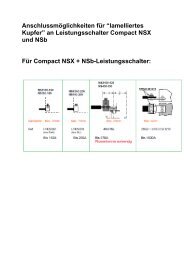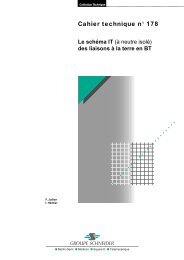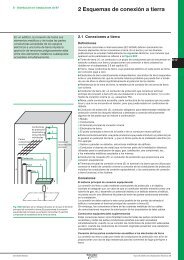Medium Voltage technical guide - Schneider Electric
Medium Voltage technical guide - Schneider Electric
Medium Voltage technical guide - Schneider Electric
Create successful ePaper yourself
Turn your PDF publications into a flip-book with our unique Google optimized e-Paper software.
Presentation Prefabricated metal-enclosed<br />
switchgear<br />
Accessibility and service continuity<br />
Some parts of a switchgear may be made accessible for the user,<br />
for various reasons from operation to maintenance, and such an access<br />
could impair the overall operation of the switchgear then decreasing<br />
the availability.<br />
The IEC 62271-200 proposes user-oriented definitions and classifications<br />
intended to describe how a given switchgear can be accessed, and what<br />
will be the consequences on the installation.<br />
The manufacturer shall state which are the parts of the switchgear which<br />
can be accessed, if any, and how safety is ensured. For that matter,<br />
compartments have to be defined, and some of them are going to be said<br />
accessible.<br />
Three categories of accessible compartments are proposed:<br />
b Interlock based access: the interlocking features of the switchboard<br />
ensure that the opening is only possible under safe conditions<br />
b Procedure based access: the access is secured by means of,<br />
for instance, a padlock and the operator shall apply proper procedures<br />
to ensure a safe access<br />
b Tool based access: if any tool is needed to open a compartment,<br />
the operator shall be aware that no provision is made to ensure a safe<br />
opening, and that proper procedures shall be applied. This category is<br />
restricted to compartments where no normal operation nor maintenance<br />
is specified.<br />
When the accessibility of the various compartments are known, then the<br />
consequences of opening a compartment on the operation of the installation<br />
can be assessed; it is the idea of Loss of Service Continuity which leads<br />
to the LSC classification proposed by the IEC: “category defining the<br />
possibility to keep other high-voltage compartments and/or functional<br />
units energised when opening a accessible high-voltage compartment”.<br />
If no accessible compartment is provided, then the LSC classification<br />
does not apply.<br />
Several categories are defined, according to “the extent to which the<br />
switchgear and controlgear are intended to remain operational in case<br />
access to a high-voltage compartment is provided”:<br />
b If any other functional unit than the one under intervention has to be<br />
switched off, then service is partial only: LSC1<br />
b If at least one set of busbars can remain live, and all other functional<br />
units can stay in service, then service is optimal: LSC2<br />
b<br />
If within a single functional unit, other(s) compartment(s) than the<br />
connection compartment is accessible, then suffix A or B can be used with<br />
classification LSC2 to distinguish whether the cables shall be dead or not<br />
when accessing this other compartment.<br />
But is there a good reason for requesting access to a given<br />
function? That’s a key point.<br />
10 AMTED300014EN.indd

















